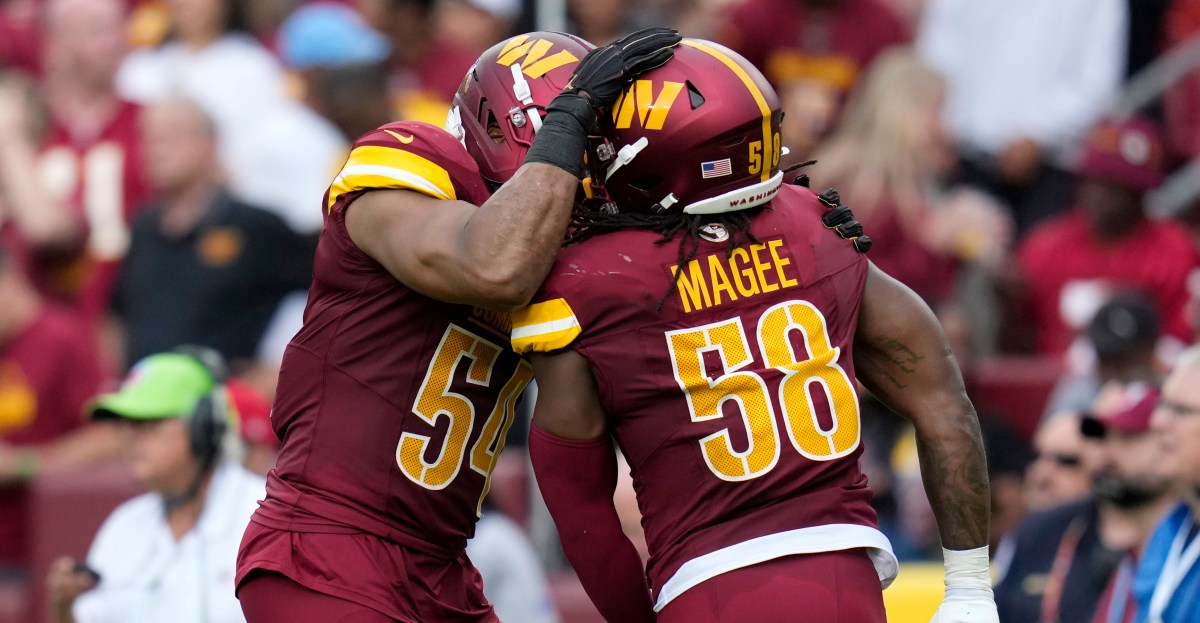The scoreboard at Arrowhead told an unforgiving story — 28–7, another primetime loss for the burgundy and gold, who now sit at 3–5.
But behind the result, within the defensive substitutions and personnel packages of Week 8, there were the first visible signs of change. Led by Dan Quinn and defensive coordinator Joe Whitt Jr., the tandem began adjusting, even just slightly, the structure of a defense that had grown old, slow, and reactive — one that simply fails to match the tempo of the modern NFL.
For the first time in 2025, speed and youth took precedence over experience. It came not in grand announcements or schematic overhauls, but through the quiet introduction of players like Jordan Magee and Tyler Owens — each embodying a specific need that has been lacking in Washington’s defense: range, adaptability, and pursuit.
The result in Kansas City was ugly, but the intention behind the lineup was clear. Washington, after weeks of masking inefficiencies with veteran steadiness, finally chose to lean into athleticism.
It may have come too late to rescue the early part of the season, but it offers a necessary blueprint for what the defense must become.
When Quinn and Whitt arrived, the expectation was that Washington’s defense would mirror the aggressive, fast-flowing identity Quinn once built in Seattle and Dallas — defenses that chased, closed, and punished offenses for stretching the field. But through the first half of 2025, the Commanders looked more static. There were flashes at times, sure, but far too often they looked a step, or two, or three, slow.
Much of that lag existed in the middle of the field. Bobby Wagner’s presence provides leadership and structure, but at 35, his coverage range is no longer what it was. Tight ends have found soft spots all around him, and backs have turned short check-downs into chunk plays with consistency. When speed becomes a liability, even perfect positioning can’t always compensate.
The front seven, once considered the team’s backbone, had its own set of injuries and inconsistencies. With Dorance Armstrong, Deatrich Wise Jr, and Javontae Jean-Baptiste each on the shelf for the long haul, the room lost its bite. Corners were forced into coverage longer, exposing spacing issues and communication breakdowns that no amount of veteran savvy could fix.
Against Patrick Mahomes, those problems were magnified. Kansas City stretched the defense horizontally, used motion to manipulate linebackers, and found advantageous matchups specifically in the second half. It wasn’t simply a talent gap even though that remains an issue — it was a speed gap. My guy is quicker than your guy.
The Commanders were reacting to plays rather than dictating them, a common theme through eight weeks.
That reality has forced Quinn and Whitt to reassess how the unit was built.
Today’s NFL offenses aren’t just faster — they’re layered, forcing defenders to cover space in ways the old positional archetypes no longer allow. And so, Week 8 became an inflection point.
For Magee, his calling card is range. A product of Temple, he brings the kind of sideline-to-sideline burst that the defense has lacked. He doesn’t have Wagner’s command of angles or veteran timing, but what he provides is the raw velocity to close space — to turn a five-yard gain into a tackle at two.
Kain Medrano, a day three pick in April, while he’s remained stapled to the inactive list or as a core special teamer, he represents the prototype of the hybrid linebacker. A former multi-level standout at UCLA, he is expected to start seeing snaps as a floating chess piece — sometimes over the slot, sometimes scraping over the top, sometimes matching tight ends in space. He’s not yet refined, but his fluidity allows Whitt to disguise coverages and blur the lines between traditional linebacker and strong safety.
Then there’s Tyler Owens, one of the more intriguing young athletes on the roster and really in all of football. Once overlooked as an undrafted rookie, Owens has earned trust through sheer versatility. He can align at nickel, play deep safety, or even hold up on the perimeter. In a league where tight ends are running 4.5s and slot receivers are built like tailbacks, that adaptability matters. Owens’ value isn’t just what position he plays — it’s that he can play several, often within the same series.
And finally, Jacob Martin, the journeyman edge rusher at the ripe age of 29 whose rotational role has grown out of necessity. With so many injuries up front, Martin’s energy and pocket-collapsing quickness have become vital.
He’s not a star, but his motor and bend bring a dimension of speed the front had been missing. When Washington can get pressure from multiple points without sending blitzes, the entire structure steadies.
These players, in their own ways, could represent the philosophical pivot Quinn and Whitt are trying to engineer, and some of what we saw in Kansas City. The Commanders have spent much of the season trying to be a power-based, gap-control defense built on discipline and communication. Now, they could lean toward a style that thrives on quickness, range, and disruption.
It’s a potential move that reflects not only an adjustment in personnel, but in mindset — from reactive to proactive, from containment to pursuit.
Every team preaches speed. But few understand what it actually means to play fast.
For Washington, playing fast means shortening pursuit angles, condensing throwing windows, and forcing quarterbacks to hold the ball that half-second longer.
Modern offenses — Kansas City, Detroit, Miami, Los Angeles, San Francisco — are built on horizontal stress. They use motion and tempo to create uncertainty, forcing defenders to declare leverage and reveal coverage. Against those systems, if your linebackers can’t run and your safeties can’t flip their hips in space, it doesn’t matter how well you tackle. You’re chasing ghosts.
That’s where players like Magee and Owens become essential. Their raw athleticism allows Washington to match motion with motion — to chase crossing routes instead of passing them off, to run with tight ends rather than rerouting them.
For Whitt, his defensive philosophy depends on speed at all three levels. The front four must collapse space, the linebackers must scrape and flow without hesitation, and the secondary must transition from deep coverage to support instantly. Without it, every play call becomes a compromise — too soft against the pass, too vulnerable against the run.
Week 8 didn’t deliver results yet, but it provided something perhaps more important: confirmation that the Commanders are willing to evolve.
This evolution extends beyond Sunday strategy. It’s also about how Washington builds its defense long-term. The Commanders have quietly spent recent drafts, free-agent cycles, and the trade market chasing traits — length, maturity, versatility — even if it meant sacrificing short-term polish.
Players like Magee and Medrano aren’t simply developmental fliers; they’re archetypes for where the league is trending. Cheap, fast, and multidimensional defenders allow a coordinator to disguise fronts and rotate without telegraphing tendencies.
From a cap-management standpoint, it’s efficient. From a schematic standpoint, it’s liberating.
At some point, the organization will have to phase out veterans who, while valuable leaders, no longer fit the physical demands of the system. Wagner is the most obvious example. His football IQ remains elite, but his lateral range does not.
And the transition away from players like him must be handled delicately — respecting experience while acknowledging necessity.
The Commanders’ path forward depends on whether their young core can develop quickly enough to make that transition seamless. Because the truth is, no scheme can hide a speed deficit forever.
Now comes the next test. The Commanders face the Seattle Seahawks on Sunday Night Football, followed by a matchup with the Detroit Lions — two teams that exemplify the kind of offensive pace and spatial stress Washington must learn to counter.
Seattle’s offense will attack the flats, pull linebackers with misdirection, and stretch coverage with play-action boots. Detroit will test eye discipline with motion and run-pass conflicts, while using RB Jahmyr Gibbs and their receivers to probe the perimeter.
These are games where speed isn’t theoretical — it’s survival. And Washington’s structure will either hold up or be exposed quickly. But the most important thing is that Quinn and Whitt are, seemingly, finally, comfortable with allowing the roster’s athletic pieces to take the field.
Even in a loss, those reps matter. They are the groundwork for an identity that can last beyond a single season.
For much of the past few years, Washington’s defense has tried to be the steady unit — bend-don’t-break, play assignment football, avoid mistakes. But the modern NFL punishes timidity. The offenses that win today attack space relentlessly. They thrive on matchups and chaos.
If you can’t run, you can’t survive.
The Commanders’ Week 8 adjustments mark the first real acknowledgment of that truth. This wasn’t about a schematic overhaul or a scapegoat firing. It was about personnel — about letting the younger, faster defenders play. It was about embracing the risk that comes with inexperience in exchange for the reward of explosiveness.
Quinn has always believed in defenses that swarm, that play with controlled aggression and speed. Whitt’s structure is designed around versatility and matchup control. Those philosophies demand athletes who can execute them.
For the first time in 2025, Washington looked willing to take that leap.
Washington’s loss to Kansas City was lopsided on the scoreboard, but internally, it may be remembered as the moment the defensive reset began.
For all the frustrations — the missed tackles, the coverage lapses, the absence of consistent pressure — there’s an emerging sense of direction. The Commanders have chosen to stop leaning on experience as a crutch and instead bet on the future: on Magee’s speed, Owens’ range, Martin’s relentlessness, and down the line, Medrano’s versatility.
It’s not a quick fix. But in a league defined by velocity, by offenses that spread you thin and force you to cover every blade of grass, it’s the only viable path forward.
Washington’s defensive rebuild won’t be measured in immediate results, but in how quickly it can transition from heavy and hesitant to fast and fearless. That process began, quietly, in Week 8 — even if it took a 28–7 loss for everyone to see it.
First Appeared on
Source link











